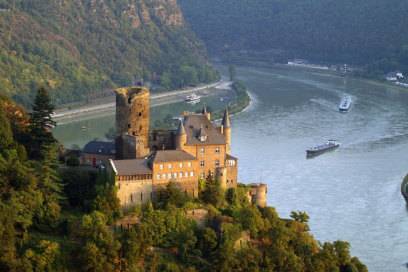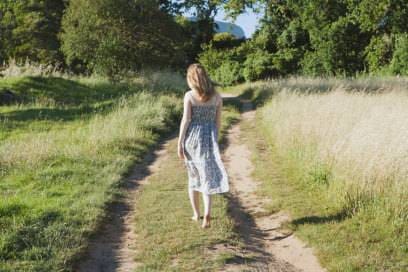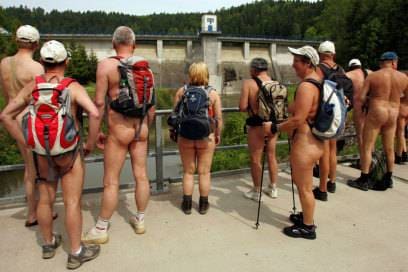September 2, 2024, 3:42 pm | Read time: 7 minutes
Simply walking from A to B is old-fashioned. Nowadays, hikers and walkers want to be entertained – whether with lynxes or in the middle of the night. Tourism associations are coming up with a lot of ideas.
To a frog concert, with champagne or completely without shoes: according to tourism experts, hiking is all the rage. “But people don’t just want to hike,” says Ulrich von dem Bruch, Managing Director of Lüneburger Heide GmbH. “They want experiences and to enjoy nature.” The tour can also be a little more unusual. Here are 13 special suggestions for hiking in Germany, among which even the most averse hiker is sure to find something suitable after all:
Hiking in Germany for lovers
Off to a rendezvous with hiking boots? It’s possible in the Harz Mountains (Lower Saxony). In the Hahnenklee-Bockswiese district of Goslar, there are 25 unique handmade wooden benches spread over seven kilometers (4.3 miles) (see photo above). Each one is dedicated to a special wedding anniversary. From the day of marriage to the extremely rare crown jewel wedding, which is celebrated after 75 years of marriage, everything is included. However, couples in love should not hold out too much hope for romantic togetherness. “Around 250,000 people hike along the Liebesbankweg every year,” estimates Isabel Junior, Head of Tourism in Hahnenklee.
For castle fans
Hiking where the Rhine is at its most breathtaking – that’s possible on the Rheinsteig (Rhineland-Palatinate). A new postcard motif is found around every bend. 320 kilometers (200 miles) on narrow paths from the Rheingau to the Siebengebirge with intoxicating views of castles as well as ruins. Demanding, but uniquely beautiful.

For sports fans
A smartphone or tablet is essential on the “Green Sport Parcours” in Egestorf (Lower Saxony). The fitness exercises along the eight-kilometer (five-mile) trail are available directly on your smartphone. So-called QR codes are attached to ten stations. If those are scanned with a smartphone or tablet, videos with fitness exercises as well as tips from former track and field athlete Heike Drechsler can be played. A tree stump, bridge railings, or a park bench serve as sports equipment. There is another high-tech fitness trail in Hamburg.
For the luxury-conscious
For Ulrich von dem Bruch, Managing Director of Lüneburger Heide GmbH, the target audience is already clear before the first hike even takes place: Tourists from Hamburg. They will be able to climb the 169-meter-high (554-foot) Wilseder Berg in the Heidekreis district at sunset and sip champagne on a viewing platform as a reward. However, according to the tourism manager, it is not yet clear when the first hike will take place.
For wine lovers
The Wiiwegli hiking trail—77 (47.8) exhilarating and tipsy kilometers (miles) that wind through vineyards and orchards in the shelter of the beautiful Black Forest—always ends in a cozy wine tavern. A hearty bacon snack with crusty farmer’s bread and a glass of Chasselas awaits afterward. The gourmet trip starts in Freiburg and ends in Weil am Rhein.
For barefoot walkers
Pure nature right under your feet: if you want to have your feet massaged by cones, bark mulch or mud, you can do so on numerous barefoot trails in the country. For example, the Hochsolling barefoot trail near Silberborn (Lower Saxony). There are 25 stations over a length of one kilometer (0.62 miles) where you can air out your feet. There are also other barefoot trails in Bad Wünnenberg in the Sauerland (NRW), in Frankenheim in the Rhön (Thuringia), as well as in Bad Sobernheim on the Nahe (Rhineland-Palatinate).

For technology freaks
Collecting markers by hand on a scavenger hunt is certainly a thing of the past. Electronic scavenger hunts (geocaching) are very much in vogue instead. Equipped with a satellite navigation device (GPS device), the aim is to find hiding places. Hiding places are searched for in advance on the Internet or in geocaching guides according to various criteria. The target coordinates are quickly entered into the GPS device, and off you go. Not every hiding place can be found right away though. Sometimes a puzzle has to be solved before.
For nudists
In Germany, the first official nude hiking trail was launched in May 2010 by innkeeper and campsite operator Heinz Ludwig in the Harz Mountains. The “Harzer Naturistenstieg” is located between Wippra and Dankerode (Saxony-Anhalt). The route is 18 kilometers (11.2 miles) long and leads from Dankerode over the Leuschner bridge through the Wippertal valley to the Wippertal dam and back. To avoid any embarrassing situations, the trail is well signposted: “If you don’t want to see any naked people, you don’t want to go any further here!” The hiking map is available for 2.95 euros.

For animal lovers
Lynxes, frogs, or birds: some tourism associations have animal hikes in their programs. Together with experts such as biologists or ornithologists, you can lace up your hiking boots and discover the animal world in Germany. In Bad Harzburg, for example, you can hike from there to a wildlife observation station. There is great interest in this. “On some days, there are up to 350 people in the forest,” says Friedhart Knolle, spokesman for the Harz National Park. Red deer can be observed from a high seat. In the Lüneburg Heath, tours are offered to tree frog concerts, heather sheep, and anthills. And in the Bavarian Forest National Park, there are guided tours where visitors can learn about the animals living in the Bavarian Forest today and in the past, their habitat, and their way of life.
For adventurers
The Wutach has carved its way almost 170 meters (186 yards) deep into the southern Black Forest. Thundering waterfalls and mossy rock faces accompany hikers on the 119-kilometer (74-mile) trip through Germany’s wildest corner, the Schluchtensteig. Which is always surrounded by kingfishers and dippers. Warning: it is not for beginners!
For night owls
Equipped with so-called bat detectors, hikers can also go bat stalking. The detectors make the sounds of the animals audible to humans. This special night hike is possible in the Harz Mountains (Lower Saxony) or in the Kalkberg caves in Bad Segeberg (Schleswig-Holstein), for example. If you like it romantic, you can also go on full moon hikes – for example in the Lüneburg Heath, in the Rhön or on the Rothaarsteig.

For the health-conscious
“Health and herbal hikes are currently very popular,” says Petra Wegener, Managing Director of Weserbergland Tourismus. In many regions of Germany, certified health hiking guides lead you through forests as well as across meadows. Treasures along the way can be discovered on herb walks. Plant experts explain which greenery is edible and which herbs are best avoided.

The best tips and routes for hiking in the Harz Mountains

And what type of a hiker are you?

The Little-Known Beauty of the Oker Valley in the Harz Mountains
For dragon fans
Legend has it that St. Magnus once killed a dragon in the Tiefental valley near Roßhaupten in the Allgäu and thus took away people’s fear of nature spirits. A new dragon trail in the Allgäu aims to bring visitors closer to the legendary memories from ancient times, according to the Südliches Allgäu tourism association. Along the approximately one-hour circular trail, there are stations that provide information about local events as well as the dragon myth. These include, for example, the stone dragon at the Tiefental bridge as well as the Drachenbrünnle in the Bachtal valley.
The original version of this article was published in 2014.

